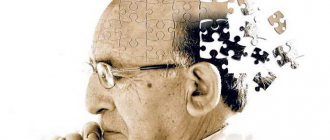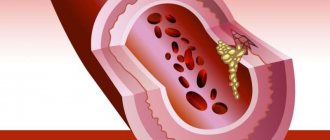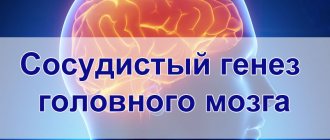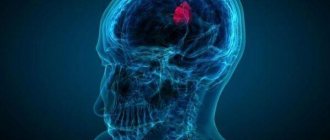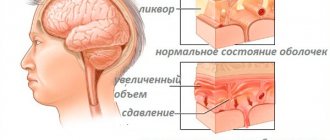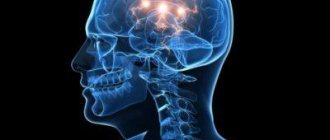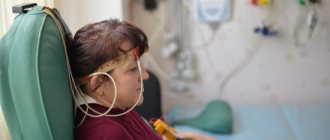Anatomical features
To understand the disease, it is important to understand the anatomy. Knowing the features of the structure of all parts of the head, both hemispheres of the brain and blood vessels, it will become easier to even identify this disease.
The venous wall of the brain does not have a valve apparatus, which is why the blood disperses freely through all adjacent vessels on different sides of the head. Almost all of them are located at a distance from each other and from the arteries. Venous sinuses are intermediate points for blood with cerebrospinal fluid from the ventricles. Vessels emerge from them. They come in two types: superficial and deep. The first are located inside the pia mater in the interlobar grooves; they are responsible for the flow of blood from the cerebral cortex to the cerebellum. The latter are formed due to the white matter with subcortical nodes.
Diploic and emissary veins are also distinguished, which conduct blood flow to the sinuses and are responsible for the connection between the superficial and deep vessels. There are also extracranial veins that provide blood supply to certain areas of the brain. In this case, all the vessels are intertwined into one, called a tank. Through it, blood flows to the central part of the brain, many sinuses and the basal plexus.
For the stable functioning of blood circulation, intervenous and intersinus anastomoses are of great importance. At the exit from the brain near the neck, three plexuses are formed: the foramen ovale of the skull, the canals of the hypoglossal nerve and the carotid artery.
What is venous discirculation
In the human body there are deep and superficial cerebral veins. Superficial ones are necessary for blood flow from the cerebral cortex, deep ones are necessary for the transfer of hemoglobin, which supplies cells with oxygen. The vessels carry blood to the sinus, after which it passes into the venous artery and leaves the brain through the vertebral arteries.
Venous discirculation of the brain is a violation of blood circulation on the way from the central nervous system to the heart muscle.
Venous discirculation of the brain is a condition of the body that is expressed by pathological changes in blood circulation in the cervical spine.
Outflow disturbance
Discirculation of venous blood flow does not have its own ICD code, but it is often classified under section G44.1, which describes vascular headache. This disorder is characterized by stagnation of venous blood in the head and neck area, which lacks oxygen, but has a large amount of toxic substances.
Impaired venous outflow of the brain is often combined with increased intracranial pressure, which occurs due to vascular dysfunction. Good blood circulation is very important for the functioning of the body; impaired blood supply can be very dangerous.
If left untreated, disability or death may occur.
Doctors distinguish two types of obstruction of venous outflow. They differ in the nature of the violations that arise. It is very important to determine what type of disease the patient has developed. The details of therapy will depend on this.
Types of violations:
- Primary. It is characterized by a significant disruption of blood flow in the brain cavity. It occurs when there are changes in venous tone, which can happen due to injuries, intoxication, problems with blood pressure, endocrine diseases or hyperinsolation.
- Stagnant. Develops anywhere in the brain as a result of mechanical stress. Typically, such changes within the tissues become critical and very dangerous, since they completely interrupt the ability of the veins to transmit blood. Patients are prescribed serious treatment along with surgery.
Also, impaired blood flow is classified according to stages. They help determine how serious it is. If in the first case the problem may not even be noticed, then in the latter case medical attention is required, and a full life without treatment becomes impossible.
Stages:
- Latent. The main symptoms are almost invisible; in most cases, patients are not even aware of health problems.
- Cerebral. Primary signs of impaired venous outflow begin to appear, the person continues to live his usual life and rarely attaches importance to mild symptoms, which can sometimes be mistaken for fatigue or non-dangerous illnesses.
- Venous encephalopathy. The third stage is characterized by the appearance of symptoms of an organic type; the patient cannot help but notice a deterioration in his health, and he requires medical attention.
You can determine the approximate extent of the disease based on your feelings, but for an accurate diagnosis you will have to undergo an examination. A full brain analysis will be required.
Forecast
By following all recommendations regarding the treatment of the underlying pathology and drug therapy, unpleasant clinical symptoms can be eliminated and the development of the disease can be delayed.
A favorable prognosis and time for complete recovery depends on the following factors:
- Success in treating the underlying disease that caused dysgemia. The prognosis for life expectancy during dyshemia is negative if the patient additionally has thrombosis or stroke. But in cases where the main cause of the disease was hypertension or diabetes mellitus, the chances of cure increase significantly.
- Presence of hypoxia. The prognosis is unfavorable if discirculation previously led to hypoxia. Even after getting rid of dysgemia, fainting or disturbances in the functioning of the cervical spine are possible.
- Age and general health. Young people have the most favorable prognosis for cure.
It is very important to identify in time all the reasons that complicate circulatory processes in the body. If you develop the correct treatment regimen in a timely manner, you can avoid serious side effects. Ignoring the symptoms of the disease ends in a decrease in intelligence, paralysis or death.
Preventive measures for the disease should be carried out before its development begins.
This requires:
- motor activity, as well as various physical exercises. Low mobility can lead to obesity, which negatively affects all internal organs of a person;
- healthy diet, excluding fatty foods, especially animal fats, as well as minimizing salt intake;
- complete cessation of cigarettes and alcohol.
The development of cerebral venous circulation in humans is a condition that requires timely administration of adequate treatment, taking into account adherence to a daily routine and a healthy lifestyle, as well as giving up bad habits. By following the recommendations, you can avoid possible side complications.
Article design: Oleg Lozinsky
Causes
The occurrence of cerebral venous dysfunction may be associated with any disease or be an independent disorder. The total number of reasons for the development of such a problem is quite large, so only a few can completely protect themselves from it. Regular medical examinations can be considered the only way to reduce the risk of the disease.
Causes:
- cervical or thoracic osteochondrosis and other vertebral disorders;
- dysfunction of the autonomic nervous system;
- previously received traumatic brain injuries;
- congestion of the cervical vessels in severe illnesses;
- the presence of thrombophlebitis inside the brain;
- sinus thrombi, venous dyshemia;
- congenital vein anomalies;
- decreased tone with vertebrobasilar insufficiency in the VB pool;
- failure of blood circulation in the VBB;
- heart failure;
- birth injuries;
- sinusitis, meningitis;
- development of brain or neck tumors;
- swelling with bone displacement;
- bronchial asthma, suffocation.
A baby may encounter the disease after childbirth if he is injured. Newborns also face this problem when they develop hydrocephalus, bone fractures or the appearance of hematomas. Sometimes a child can grow normally without signs of abnormalities, but a violation of the venous outflow appears a little later. With birth injuries, consequences can only arise in adulthood.
Risk factors include: excessive physical exertion, frequent standing upside down, regular holding of breath, excessively tightened collars, loud screaming, prolonged cough. In some cases, it is enough to exclude these moments from life to reduce risks to a minimum.
Symptoms
If clear symptoms of a violation of the venous outflow of the brain appear, immediate treatment is required, since it can be difficult to get rid of them on your own. They cause the patient to experience serious discomfort, which prevents them from living a full life. Symptoms can vary significantly between people, even at the same stages of the disease.
The main symptom is headache. It can be episodic or chronic. For some it manifests itself as a bright pain, while for others it causes a pressing feeling throughout the head. It can affect both the front or back of the head, and the left or right.
The disease is also detected by other signs:
- dizziness;
- darkening of the eyes;
- high fatigue;
- decreased intellectual activity;
- increased irritability;
- poor sleep, sleepy state during the day;
- tendency to have depressive thoughts;
- physical weakness;
- noise or ringing in the ears;
- nausea and vomiting;
- increase in body temperature;
- slight swelling of the face;
- redness of the eyes in the morning;
- loss of consciousness;
- hair loss when combined with osteochondrosis;
- numbness or tremor of the limbs;
- slowness of action;
- epileptic seizures;
- asymmetry of the nasolabial folds of the face.
With severe disruption of the blood supply to the deep veins, coma is possible. Some other veins that do not receive blood can lead to otitis media, pus formation, and pain when chewing. Infections can sometimes interfere with blood circulation. In such cases, a brain abscess or encephalitis may develop.
In young children, the problem may manifest itself as hypoxic changes in the brain. External manifestations are limited to frequent screams.
Signs of obstruction of venous outflow can significantly expand if the patient does not engage in treatment. To these will be added complications, the development of which is caused by the destruction of brain cells. Impaired outflow can cause Alzheimer's disease and dyscirculatory encephalopathy. Such severe complications lead to disability, which negates the chances of a full return to work in the future.
Characteristic signs in children
Venous discirculation of the brain in children is a condition characterized by the following symptoms:
- increase in temperature;
- pain in the area of poor blood supply;
- impaired coordination of movements;
- migraine;
- paralysis;
- involuntary movements;
- nose bleed;
- convulsions;
- metabolic disorder;
- changes in speech;
- chills;
- increase in blood pressure.
Diagnostics
It is not possible to make a diagnosis based on symptoms for such disorders. The patient will definitely have to undergo special diagnostics, which will show the condition of all veins and the brain. Specialists also examine the fundus of the eye for congestion.
What examinations will you need to undergo:
- radiography - usually prescribed for cases of traumatic brain injury in the past;
- computed tomography - helps to study the consequences of strokes or hematomas;
- MR tomography - shows the presence of tumors, aneurysmal dilatations of veins, changes in the structure of the ventricles;
- fundus examination - prescribed to identify existing dilations of the venous bed;
- Ultrasound of the vessels of the neck - reveals probable stenosis, determines the speed of blood flow and the fact of its decrease.
When blood flow is impaired, the pressure in the dominant jugular veins does not change, but the speed of blood movement inside the basilar arteries decreases. The activity of all other blood vessels also decreases. Based on the results obtained, the doctor will be able to make a final diagnosis.
Basic therapy
In the early stages, the disease can be easily suppressed with simple treatment. If disturbances increase the lack of blood flow, then more serious actions will have to be taken. Some may require surgery to restore blood supply to the brain. It is prescribed only in the most severe cases, when other methods are not effective enough.
The main drugs for such disorders act on the veins, helping to improve blood flow. At the same time, they strengthen blood vessels, increase their tone and suppress inflammatory processes. You can take them at home without staying in hospital. However, it is important to follow your doctor's orders and get checked regularly.
The best medicines:
- "Excusan";
- "Detralex";
- "Doctor Theiss";
- "Anavenol";
- "Antistax."
During treatment, you should definitely stop eating junk food, alcohol and smoking. After recovery, it is not recommended to return to them, since they can provoke the recurrence of problems, due to which the outflow of blood from the head will again be disrupted.
Patients with such disorders are drafted into the army under category B-4, but in the presence of serious surges in blood pressure or other severe manifestations of the disease, the conscript can count on category B, which indicates fitness for service only under martial law. After treatment, the commission's decision may be revised.
Operation
If the disturbances in circulation are very significant, then the specialist recommends surgical intervention. But surgery is used if medications fail to help.
Main types of operations:
- Angioplasty: A catheter is inserted into part of an artery to improve blood circulation and enlarge its walls.
- Bypass surgery: an artificial vessel is placed near the narrowing of the vein. This creates a new pathway for the bloodstream to move.
- Endarterectomy is a method of removing the inner part of the affected capillary.
Complementary therapy
To increase the effectiveness of treatment, it is recommended to normalize nutrition, do morning exercises, increase the level of physical activity, walk in the fresh air more often and get enough sleep. It is also recommended to pay attention to two good ways to combat this disease: osteopathy and gymnastics.
Osteopathic techniques normalize the tone of the veins, increase blood flow and strengthen the nervous system. To do this, you need to correctly physically influence the patient’s arms and spine, performing gentle movements. The effectiveness of this method is very high, but osteopathy requires certain skills. Therefore, you will need to attend specialist sessions.
Simple exercises will help improve your condition. They are performed at a convenient time. You just need to tilt your head in each direction for a minute, try to stretch it towards the ceiling as you inhale, draw a figure eight with the top of your head, or press your head on your palms folded under it, which should be used to exert slight resistance. After this, it is best to massage your neck with light movements, relaxing as much as possible.
Traditional methods
The use of traditional methods will further increase the effectiveness of therapy. In mild stages of the disease, they may generally be enough for a complete recovery. But before using them, you should inform your doctor about this.
Effective folk remedies:
- Mix hawthorn tincture with rose hips, add 15 drops per third of a glass. You need to drink this drink half an hour before meals, once a day.
- Pour a glass of boiling water over a spoonful of corn silk, add two tablespoons of honey. Take three spoons daily.
- Combine equal amounts of birch buds, parsnips, dandelion and licorice roots, thyme and burdock. Pour boiling water over everything and let it brew. Drink a glass daily.
- Purchase a ready-made aqueous extract of Ginkgo biloba leaves and administer 2 ml intravenously every day. The duration of treatment is 10 days.
- Simmer two tablespoons of sweet clover herb in 200 ml of boiling water for 15 minutes in a water bath, filter after 45 minutes. Take 50 ml three times a day.
Some components may cause an allergic reaction or provoke an exacerbation of chronic diseases. Therefore, you should exercise special caution when deciding to be treated with traditional methods.
If venous outflow is obstructed, the person will experience a lot of unpleasant symptoms. When the first suspicion of blood flow disturbances appears, you should immediately undergo examinations, on the basis of which treatment is prescribed. With such a pathology, it is especially important, since without it the patient will face severe complications. And with timely treatment, everyone has every chance of recovery.



